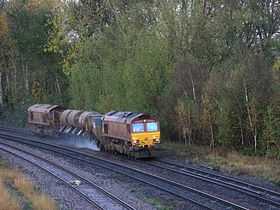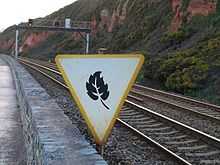Slippery rail

Slippery rail is a condition of railways (railroads) caused by fallen moist leaves that lie on and cling to the top surface of the rails of railway tracks. The condition results in significant reduction in friction between train wheels and rails, and in extreme cases can render the track temporarily unusable. In Britain, the situation is colloquially referred to as "leaves on the line".
Causes

In heavily deciduous forested areas like the American Mid-Atlantic states, New England, many parts of Europe including the UK, and Southern Ontario, Canada, where there is heavy leaf fall in the autumn, the problem can arise. Where the leaves fall across a railway route, some of the leaves fall on the railheads; and at the passage of the next train, they are heavily compressed into a slippery low-friction coating on the rail and on the wheel treads. If the climate is damp, the wet leaves adhere to the rail very effectively. The draft caused by the passage of the train causes nearby leaves to be caught up in air currents, and more leaves are deposited on the railhead.
The build up of this material is incremental, and it is hard enough not to be quickly worn away by the ordinary passage of trains.[1][2]
Disc brakes
Before about 1960, most railway vehicles had brake shoes that applied pressure to the wheel treads. Since then, disc brakes have increasingly been used instead. Brake shoes have some effect in cleaning (by abrasion) the compressed leaf material from the wheel tread, but in other respects disc brakes are superior.[3]
Lineside maintenance
In the steam locomotive era, trees and other lineside vegetation would be regularly cut back to reduce the risk of their being ignited by sparks from the locomotive. As the railways ceased to use steam traction, this maintenance was allowed to lapse, and the resulting extra growth increased the supply of leaves thereby exacerbating the problem.[4]
Effects
The loss of friction between wheels and rail results in loss of tractive force — the train cannot move forward and the wheels merely spin, uselessly. In braking, substantial loss of friction results in the braking becoming ineffective, with the wheels locking. (Modern traction and braking control systems modify these effects and are not elaborated here, but the end result is similar.) Locked wheels can self-grind "flats" on the steel tyres, especially if the wheels are still sliding when arriving at a non-greasy section of rail, e.g. one that has previously been sanded. These flats subsequently cause severe vibration and the wheels must be re-profiled or re-tyred at great expense.
In extreme cases also, the build-up of leaf material can electrically insulate the wheels from the rails, resulting in a dangerous failure of signalling equipment to detect the presence of the train.
In summary, the railway can quickly become inoperable, or incur serious and cumulative delay as trains are unable to maintain normal point-to-point timings.
In the United Kingdom, it was estimated that the autumn leaves problem cost the rail industry GBP 60 million (USD 115 million) a year.[5][6]
Mitigation measures
On track
Railways' mitigation measures generally involve some system to jet or blast the accumulated deposit away, or to coat it with a high-friction material. Blasting is usually carried out with water jets, often in combination with mechanical scrubbing apparatus. The coating method usually involves depositing sand in a paste on to the rail; as the sand may exacerbate the risk of unwanted insulation, the sand mix sometimes contains ferrous particles. The coating is applied from special trains (colloquially referred to as "Sandite" trains after the original proprietary mixture applied) and in some cases locally by hand.
Both of these processes are effective for a limited duration; the jetting method is ineffective as soon as the next leaf falls; the sand deposition method is more durable, although rainfall usually removes the deposited sand quickly.
Train handling is modified in areas and at times when leaf fall is expected; sharp acceleration and braking are avoided. In the UK a special, somewhat less congested, timetable is published and operated at these times.
Removal of deciduous trees at the lineside is a management method to control the problem; however, there is political resistance to this in populous areas.
On train
Modern locomotives and trains are equipped with wheel slide protection to counter slippery rail conditions.
North America
Slippery rail has created severe disruptions of rail service, particularly in major metropolitan areas such as New York or Boston. In November 2006, it was blamed for roughly one-third of all Metro-North Railroad's Hudson and Harlem lines' passenger cars being taken out of service.[2] During the same period on the Long Island Rail Road, nearly 25% of cars were out of service due to slippery rail.[5][7]
In the US, Amtrak, the Massachusetts Bay Transportation Authority, southeastern Pennsylvania's SEPTA,[8] Chicago's commuter rail service Metra, and MARC, which serves Baltimore and Washington, D.C., have all reported delays due to slippery rail.[1]
Methods for dealing with slippery rail have included trimming trees, the release of sand on the train wheels for traction, high-pressure water blasting and, most expensively, the use of high-powered laser blasts to clear the rails of leaves.[1][9]
Metro-North has designed a system dubbed "Waterworld", which is a large flat rail car that blasts the rails with high-pressure water jets as the car moves over it.[10]
New Jersey Transit has used a similar method, which has proven effective. The device it uses is called "Aqua-Track" which, while attached to a moving rail car, sprays water at a pressure of 100,000 psi (690 MPa) on to the part of the rail where the leaves cling.[1] Since this system was introduced in 2002, the delays due to wheelslip have been reduced by over 60%.[2]
SEPTA Regional Rail's method of preventing slippery rail is the Gel Trains. These two trains spray a high-pressure mixture of sandite on the rails; in the fall, the Gel Trains also clean the rails using the high-pressure water jet method ahead of the gel application. These trains consist of a pressure washer and gel dispenser mounted on a converted flatcar, and a tank car which carries water. They are pulled on one end by one of SEPTA's work diesels (or a diesel borrowed from a local shortline such as the West Chester Railroad), and controlled at the other end by a former LIRR "Power Pack" cab unit (one a former ALCO FA, the other a former EMD F7).[11][12]
United Kingdom
In the United Kingdom, a number of rail companies change their timings and publish special "leaf fall timetables".[13][14]
The cryptic nature of rail company explanations for slippery rail and related phenomena made the phrase "leaves on the line" a standing joke,[4] and, along with variants such as "the wrong type of snow", is seen by members of the public who do not understand the problem as an excuse for poor service.[15][16]
Particularly problematic local trees include the sycamore, lime, sweet and horse chestnut, ash, and poplar, which regrow or coppice after cutting back, and have large, flat leaves, which stick to the line and cause severe slippery rail.[4] Other types of tree that cause problems are quick-growing, pioneering trees, or those producing a substantial amount of leaves. Poplars are particularly troubling because they tend to shed limbs.[17]
A term current in 2003 for cutting down or cutting back trees near the lines was "lineside vegetation management".[17]
Netherlands
Slippery rail is also a problem in the Netherlands, addressed by Nederlandse Spoorwegen and ProRail.[18] To prevent wheel lock, on some routes trains are required to brake earlier and accelerate more slowly. Furthermore, some (passenger) trains are fitted with equipment to apply Sandite gel on the tracks.[19]
Other causes
Similar problems have been attributed to crushed migrating caterpillars in Victoria, Australia in 2012 and crushed locusts on the Otavi Mining and Railway Company in German South-West Africa (modern Namibia) in 1924. Slippery rails caused by caterpillars were reported in Queensland in 1938.[20]
The crushing of millipedes is suspected to have caused a crash between two trains at Clarkson near Perth, Australia in September 2013[21]
See also
- Adhesion railway
- Sandbox (railways)
- Sandite
- Tram sanders
- Tribology
References
- ↑ 1.0 1.1 1.2 1.3 Holmes, Elizabeth (November 21, 2006). "Why your train is late when autumn leaves fall (free preview)". The Wall Street Journal online. Retrieved November 22, 2006.
- ↑ 2.0 2.1 2.2 Halbfinger, Caren (November 21, 2006). "'Flat wheels' deflate train commuters". The Journal News (White Plains, New York). Retrieved November 22, 2006.
- ↑ Wolmar, Christian (February 20, 1995). "Disc brakes linked to rise in train "slides"". The Independent (London). Retrieved July 21, 2012.
- ↑ 4.0 4.1 4.2 "Royal Forestry Society: Leaves on the Line". Retrieved July 21, 2012.
- ↑ 5.0 5.1 Aitchison, Gavin (November 21, 2006). "Leaves on line cause rail delays". The Press (York). Retrieved November 22, 2006.
- ↑ "Biggest Ever Campaign Unveiled for Autumn Leaf-Fall Battle" (Press release). Network Rail (UK). October 16, 2006. Retrieved November 22, 2006.
- ↑ "Commuters, expect train delays". WABC-TV (New York). November 22, 2006. Retrieved November 22, 2006.
- ↑ http://septa.com/travel_advisory/slipperyrail.html
- ↑ "Lasers clear leaves on the line". Physicsweb. Retrieved January 22, 2007.
- ↑ Silberstein, Judy (November 15, 2006). "Commuters Warned Of "Slippery Rail" Delay". Larchmont Gazette (New York State). Retrieved November 22, 2006.
- ↑ Almeida, John P. "SEPTA Gel Train with F7 622 Philadelphia PA November 12, 2006". Railfan Pictures of the Day. The Philadelphia Chapter of the National Railway Historical Society. Retrieved February 12, 2013.
- ↑ Almeida, John P. "What do you use to rescue a SEPTA gel train? Another SEPTA gel train! October 16, 2008". Railfan Pictures of the Day. The Philadelphia Chapter of the National Railway Historical Society. Retrieved February 12, 2013.
- ↑ Leaf fall timetable falls into place
- ↑ Autumn leaf fall: Changes to train times, South West Trains.
- ↑ Wainwright, Martin (April 20, 2004). "Wrong type of pressure halts new trains". The Guardian (London).
- ↑ Going Loco – your bizarre train tales, BBC
- ↑ 17.0 17.1 May, John (October 22, 2003). "Get a Grip". The Guardian (London).
- ↑ Article, International Railway Journal, October 2003
- ↑ http://www.youtube.com/watch?v=OhYEREMr1Oo
- ↑ "CATERPILLARS.". Townsville Daily Bulletin (Qld.: National Library of Australia). October 24, 1938. p. 6. Retrieved October 8, 2012.
- ↑ "Millipedes suspected in Perth train crash". The Australian. September 3, 2013.